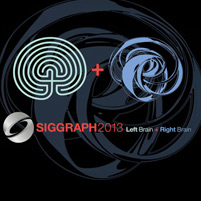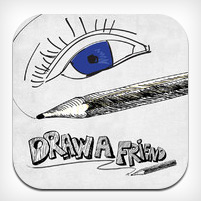SIGGRAPH Highlights


DrawAFriend app
From artistic apps to animation to internal tagging, scientists from Carnegie Mellon University made an impressive showing at SIGGRAPH 2013, the International Conference on Computer Graphics and Interactive Techniques in Anaheim, Calif.
More than 20,000 professionals from five continents saw their latest developments.
Drawing Assistance. Alex Limpaecher (CS'13), a Ph.D. student in the Computer Science Department, and his advisor, Adrien Treuille, associate professor of computer science and robotics, presented an app created by CMU and Microsoft researchers that automatically corrects a person's drawing strokes on a touchscreen while preserving the user's artistic style.
This novel application of Big Data was enabled by DrawAFriend, an iPhone drawing game the researchers conceived, which generated a database of more than 17,000 drawings of faces.
In addition to the drawing assistance app, the database could also be used to develop better object recognition or scene analysis for computer vision systems, as well as teaching tools to improve the artistic techniques.
"We are in the middle of a Big Data revolution," Treuille said. "We've found that Big Data can be used to do amazing things. But success is not inevitable; you have to have the dataset first. With DrawAFriend, we've found a way to use crowdsourcing to create this critical resource for a data-impoverished phenomenon."
Improving Animation. Treuille also led a study by CMU and University of California, Berkeley, scientists that will improve real-time animation of complex phenomena for video games, such as a naturally flowing robe or a team of galloping horses.
Doyub Kim, a former post-doctoral researcher at CMU, presented the team's findings, which are based on six months of computation that generated a detailed portrait of the behavior of a piece of cloth.
To create this cloth database, the team took advantage of the immense computing power available in the cloud, ultimately using 4,554 central processing unit (CPU) hours to generate 33 gigabytes of data.
Treuille said this presents a new paradigm for computer graphics, in which it will be possible to provide real-time simulation for virtually any complex phenomenon.
Internal Tagging. And in light of the age of 3D printing, Karl Willis (A'13), a recent Ph.D. graduate in computational design, and Andy Wilson, a principal researcher at Microsoft, demonstrated how tags could be created inside objects as part of the 3D printing process and the Terahertz (THz) imaging and data processing steps necessary to read these internal tags.
THz radiation falls between microwaves and infrared light on the electromagnetic spectrum. It can penetrate many common plastics, papers and textiles but, unlike X-rays, does not harm biological tissues.
THz imaging has yet to be fully commercialized. NASA famously has used it for inspecting the protective tiles on the space shuttle, detecting the same sort of voids Willis and Wilson have now used to encode information with InfraStructs.
The tags could be used for a number of applications beyond keeping track of inventory or making point-of-sale transactions.
Related Links: School of Computer Science | Read more: Internal Tagging | Read more: Real-time Animation | Read more: Drawing Assistance App
